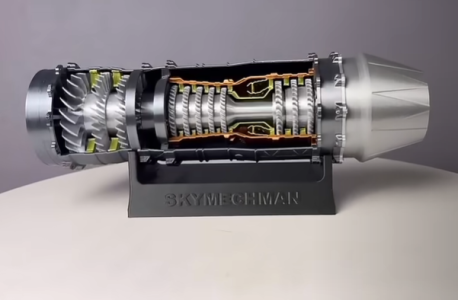Evening,
I got a 1/18 scale WS-15 turbofan engine. It's not very big. It is long and lightweight, but what makes it stand out is that it's not just for display. It actually does stuff.
What drew me in was the mix of aesthetics and mechanics. The cutaway design looks awesome, sure, but what really surprised me was how many internal components actually move. You can manually spin the turbine blades, watch the fan gear system in action, and there's even a bypass airflow channel (though I'll admit I didn't totally figure that part out yet, haha). Watching it run after assembly feels like having a mini aviation museum exhibit right on your desk.
To be honest, I usually prefer metal models—3D-printed kits often fall short for me when it comes to feel and precision. But I made an exception for this one, mainly because of two things: it's motorized and it has working lights. That lighting effect simulating a real engine environment? Total game changer. None of my previous builds had that, so it definitely brought something fresh to the table.
What really impressed me was the assembly accuracy. The fan section has some pretty tight tolerances and small parts, and even though it's plastic, the fit and finish were better than I expected. It takes a bit of patience, but nothing crazy.
Before starting, I was honestly a bit worried I'd mess it up, so I watched a bunch of teardown and assembly videos, especially to figure out the low-pressure compressor setup. But once I actually got into it, the whole build process was surprisingly straightforward. Took me less than two hours from start to finish, and I bet some of you could do it even faster.
Cheers!

I got a 1/18 scale WS-15 turbofan engine. It's not very big. It is long and lightweight, but what makes it stand out is that it's not just for display. It actually does stuff.
What drew me in was the mix of aesthetics and mechanics. The cutaway design looks awesome, sure, but what really surprised me was how many internal components actually move. You can manually spin the turbine blades, watch the fan gear system in action, and there's even a bypass airflow channel (though I'll admit I didn't totally figure that part out yet, haha). Watching it run after assembly feels like having a mini aviation museum exhibit right on your desk.
To be honest, I usually prefer metal models—3D-printed kits often fall short for me when it comes to feel and precision. But I made an exception for this one, mainly because of two things: it's motorized and it has working lights. That lighting effect simulating a real engine environment? Total game changer. None of my previous builds had that, so it definitely brought something fresh to the table.
What really impressed me was the assembly accuracy. The fan section has some pretty tight tolerances and small parts, and even though it's plastic, the fit and finish were better than I expected. It takes a bit of patience, but nothing crazy.
Before starting, I was honestly a bit worried I'd mess it up, so I watched a bunch of teardown and assembly videos, especially to figure out the low-pressure compressor setup. But once I actually got into it, the whole build process was surprisingly straightforward. Took me less than two hours from start to finish, and I bet some of you could do it even faster.
Cheers!

Last edited: